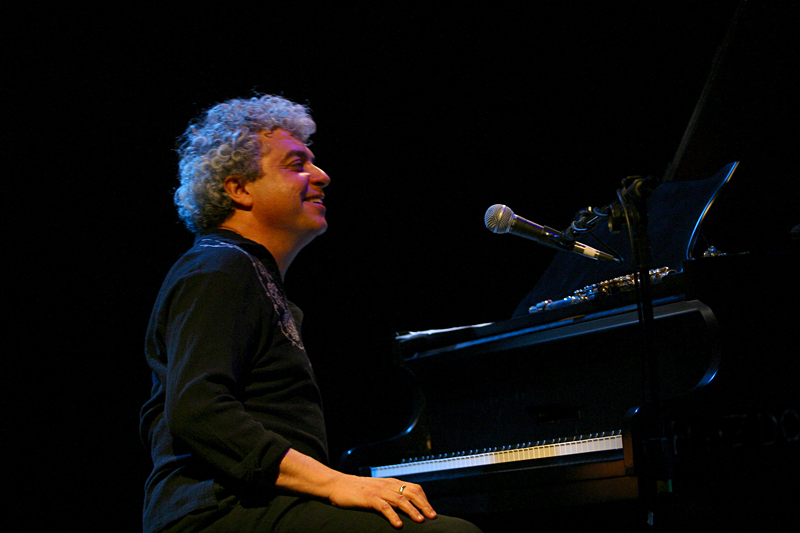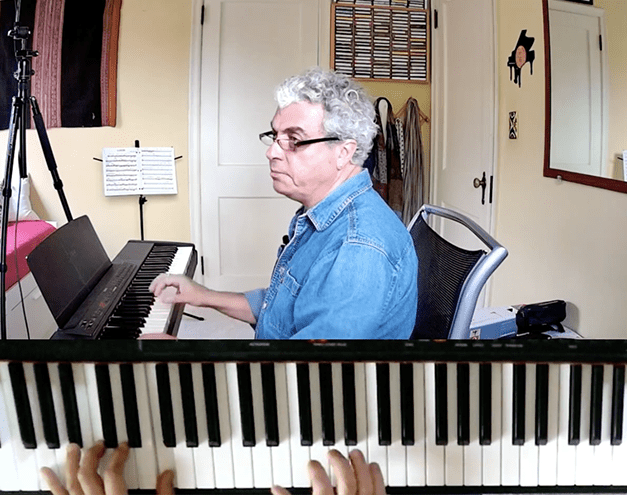
Jovino Santos Neto
Three-time Latin Grammy nominee Jovino Santos Neto, a master pianist, composer and arranger, is among the top Brazilian musicians working today.
Live Seminar Resources
Live Seminar Resources
PDF Downloads
- Dindi - Chord Chart
Join PianoGroove Pro to access all downloads and learning resources.
Download theory supplements, midi files, chord changes and full note-for-note transcriptions of every lesson.
- Where or When - Chord Chart
Join PianoGroove Pro to access all downloads and learning resources.
Download theory supplements, midi files, chord changes and full note-for-note transcriptions of every lesson.
Related Lessons
Forum Threads
Seminar Description
Seminar Description
Bossa Nova Comping Patterns for Beginners
Welcome to this lesson on Bossa Nova comping patterns for beginner jazz pianists. In this lesson, we explore the essential rhythmic foundations of Bossa Nova and learn how to develop a smooth and balanced comping technique. By the end of this lesson, you will have a clear understanding of how to apply these patterns in your playing, whether accompanying a vocalist, instrumentalist, or playing solo piano.
Understanding Bossa Nova Rhythm
Bossa Nova is deeply rooted in Samba, a Brazilian rhythmic style characterized by syncopation and groove. While Samba is typically played with multiple percussionists, Bossa Nova simplifies the rhythm into a more subtle and laid-back feel.
A key concept in playing Bossa Nova is that there is no rhythm without movement. This means that to develop an authentic Bossa Nova feel, you need to internalize the motion behind the rhythm rather than just counting beats.
Bossa Nova comping patterns are built on binary subdivisions (groups of two), typically based on quarter notes, eighth notes, and sixteenth notes. The comping style can be thought of as a “drumming pattern without the drums,” where the pianist mimics the rhythmic pulse of the percussion section.
The Essential Three-Layer Bossa Nova Pattern
In this lesson, we introduce a three-layered comping approach that helps create a smooth and natural Bossa Nova feel.
Layer 1: The Non-Syncopated Pulse
- This layer consists of steady eighth-note chords on beats 1 and 3.
- It provides a solid rhythmic foundation and keeps the feel light and controlled.
Layer 2: The First Syncopation
- The second layer introduces an offbeat syncopation, played just after beat 2.
- This syncopation adds the signature Bossa Nova groove and mimics the natural movement of the rhythm.
Layer 3: The Anticipation
- The third layer introduces a second syncopation right before beat 4.
- This anticipation of the harmony before the strong beat is a defining characteristic of Bossa Nova.
When put together, these three layers form the classic Bossa Nova comping pattern that underpins the style.
Applying the Pattern to Chord Progressions
Once you’ve internalized the basic rhythmic layers, the next step is applying them to common jazz progressions. For example, a 2-5-1 progression like C-7 to F7 to Bbmaj7 can be played using the full three-layer comping pattern.
One of the key characteristics of Bossa Nova comping is that chord changes often happen before the beat (anticipation) rather than on the strong beat. This creates a flowing, forward-moving feel that is essential to the style.
Practicing with Repertoire
We apply this comping technique to two well-known songs:
"Where or When" – A Jazz Standard in Bossa Nova Style
- This classic tune is typically played as a ballad, but adapting it to a Bossa Nova groove showcases the versatility of the style.
- The key takeaway here is keeping a relaxed feel while maintaining rhythmic evenness.
"Dindi" – A Classic Bossa Nova Tune
- Written by Antônio Carlos Jobim, this tune is naturally suited for Bossa Nova comping.
- The harmonic movement often involves minor 6th chords (e.g., C-6 instead of C-7), which are characteristic of Jobim’s harmonic language.
- Understanding the interplay between major 7th, minor 6th, and dominant 7th chords helps in achieving an authentic Brazilian sound.
5 Practice Tips for Bossa Nova Comping
-
Internalize the Motion – Walk or tap your foot while playing to feel the natural motion behind the rhythm.
-
Practice Hands Separately – Start with just the left-hand bass notes before adding the right-hand comping pattern.
-
Focus on Evenness – Each chord attack should be even and relaxed—avoid "stabbing" at the keys.
-
Use a Metronome or Backing Track – Apps like “iBaTuki” provide authentic Brazilian rhythm loops for practice.
- Listen to the Masters – Study recordings of João Gilberto, Antônio Carlos Jobim, and Elis Regina to absorb the authentic groove.
Mastering Bossa Nova comping takes patience and practice, but once internalized, it opens up a world of beautiful and expressive playing. Keep practicing, stay relaxed, and most importantly—enjoy the groove!







Thanks Jovino for a fine session. And thanks for mentioning the eBatuque app. I somehow missed any mention of it before, and it’s just what I’ve been looking for.
It would be great if you could work up a Live Seminar on samba jazz, showing what it is and how it differs from bossa nova. I’ve been listening quite a bit to Osmar Milito’s 2006 album *Samba Jazz*. I’m especially taken by track 5, “Començou de Brincadeira.”
At any rate, thanks again.
Hi Scott,
Glad you enjoyed the session. I have just added added the light-up keyboard to better review the material covered.
Yes let’s do a session on Samba Jazz next month – I will pass your tune suggestions onto Jovino to cover in the session.
Cheers,
Hayden